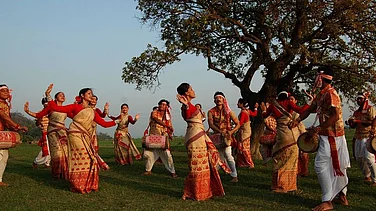Who is Tirthankara?
Mahavir Jayanti, celebrated on March 27, 2025, honors the birth of Bhagwan Mahavira, the 24th Tirthankara.
The word "Tirthankar" comes from the words 'Tirtha' which is a sacred place and the word 'Samsara' means worldly life. Tirthankars are the ones who create paths through endless cycles of deaths and births. There are 24 Tirthankars in Jainism making it one of the oldest religions. A Tirthankar isn't a god with human form. They're normal souls that were created as human beings, who develop into Tirthankars through intense penance, and meditation. Therefore it's true that a Tirthankar represents the most advanced stage of the soul.
It's not being a godlike entity. They're not the founders of religions as they are wise, knowledgeable, and leaders who lived through different periods of time. They were able to reach the highest spiritual horizon and taught others how they could reach the same level. Jain cosmology recognizes 24 Tirthankaras in each half-cycle of time, with figures like Rishabhanatha (the first) and Mahavira (the 24th and last of the current cycle) holding significant importance.
Core Teachings of Tirthankara
The enlightened ones didn't do magic. They achieved moksha, liberation away from the cycle of death with rigorous self-control and mindfulness. They tirelessly proclaimed the way to liberation which is the foundation of Jain philosophical thought.
Their instruction was based on three principal concepts:
Ahimsa: non-violence toward all living creatures, even tiny insects.
Aparigraha: Non-attachment to all material objects and wants.
Anekantavad: The many-sidedness of truth i.e. looking at things from different perspectives.
In accordance with these principles, Jain followers strive to be spiritually pure. The Jain believe that every person is destined to be a Tirthankara and a winner over the inner adversaries which include greed, anger, and self-esteem.
The 24 Tirthankars
Rishabhanatha was a teacher of non-attachment. His symbol, the bull represented strength and gentleness.
Ajitanatha sent out messages of peace, represented by the elephant which symbolizes power without ill intent.
Sambhavanatha encouraged equality, using the symbol of the horse which symbolizes rapid progress for everyone.
Abhinandananatha took pride in the other's success. His symbol was the monkey representing joy and community.
Sumatinatha shared wisdom, symbolized by the curlew bird well-known for its ability to discern.
Padmaprabha illuminated the path to purity with the lotus symbolizing an uncontaminated soul, free from the filth of desire.
Suparshvanatha was calm, and his symbol was the swastika symbolizing his four states of existence.
Chandraprabha shined with clarity and clarity, using the moon as his symbol. It stood as a beacon of light through the darkness.
Pushpadanta was a man who spoke the truth with sweetness, and his symbol is a crocodile which is powerful yet quiet.
Shitalanatha was a teacher of self-control. It is symbolized by the srivatsa symbol, which is a symbol of endless good virtue.
Shreyansanatha taught about generosity, using the rhinoceros symbol representing strength in solitary.
Vasupujya stood for detachment. His symbol is the buffalo, a creature that has a lot of content with little things.
Vimalanatha taught about purity with the pig being his symbol, despite misconceptions of a pig being a dirty animal.
Anantanatha was a whisperer of infinity. His symbol is the bear, one of the creatures that is deeply contemplative when it is hibernating.
Dharmanatha stood for righteousness and was symbolized by the vajra, a weapon that can strike but also defend.
Shantinatha taught about being calm. His symbol is the deer which is a kind and peaceful animal.
Kunthunatha weaved unity, as represented by the goat, which thrives within groups.
Aranatha always taught about protection and freedom. His symbol was the fish which is free to move about, without attachment to the ocean it is swimming in.
Mallinatha challenged the norms set by society. His symbol, the jar of water, symbolizes fluidity and flexibility.
Munisuvrata loved silence. His symbol is the tortoise, who is mostly silent while contemplating.
Naminatha was a reminder of respect. His symbol was the blue lotus symbolizing dignity and respect.
Neminatha was a voice of compassion. His emblem was the conch shell whose sounds can be heard far and wide.
Parshvanatha was a protector for all living things and his symbol is the snake, which provides a protective umbrella.
Mahavira, The legendary hero, concluded the path with everyone's teachings. His symbol was the lion, the king of self-control and power.
Jains celebrate Mahavir Jayanti and honour the last Tirthankara, not as God, but as a loving teacher. Every Tirthankara with their distinctive symbol and meaning, adds to the rich culture of Jain thinking. If you follow their way, Jains believe anyone can beat their own inner fears and attain ultimate freedom.
Happy Mahavir Jayanti 2025!























